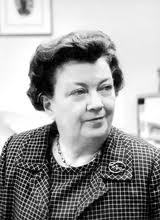This is, I believe, the first time I’ve written about someone without an IMDb page or, to be honest, any reason to have one. While Ursula Nordstrom did herself write The Secret Language, it has never been adapted. Books that she was involved with that were adapted, however, include Where the Wild Things Are, Harriet the Spy, and Charlotte’s Web. Many more works she edited have not been adapted but form the canon of children’s literature, such as In the Night Kitchen, Where the Sidewalk Ends, and The Runaway Bunny. Children’s literature would not look the way it does without the push of Ursula Nordstrom.
Nordstrom hated the kind of sweet, innocent children’s literature where everyone is pure and wholesome and the bullies get punished. She felt it was an inaccurate reflection of children’s lives—and therefore not the kind of thing that would get children to actually read. She mentored Maurice Sendak, defending him against librarians who did not understand what his work was accomplishing. Those who didn’t outright dislike the books she got published would call them “ahead of their time.”
Most of Nordstrom’s authors wrote books that celebrated the outsider in some way. Max, furious at his mother. Harriet, too smart for her own good and badly socialized—and Beth Ellen, shy and confused and the first girl in children’s literature to explicitly have a period. Stuart Little, the mouse adopted by humans. The many oddities in the poetry of Shel Silverstein. William, the little boy more interested in a doll than a football helmet. And so forth.
For the picture books she edited, she worked to ensure that authors and illustrators could work well together, believing that produced the best books. Oh, so there were times this wasn’t an issue—Maurice Sendak, for example, did both for himself. And Crockett Johnson did Harold and the Purple Crayon and its half-dozen sequels. On the other hand, he had a successful working partnership with his wife, Ruth Krauss, who also wrote several books illustrated by Sendak. Nordstrom also paired Margaret Wise Brown with Clement Hurd, producing The Runaway Bunny and Goodnight Moon, among others.
And if you know anything about children’s authors of the mid twentieth century, you’re noticing another theme running in many, though of course not all, of those authors. I don’t think it’s known for certain that Nordstrom championed other queer voices—we do, of course, know that she herself was queer; she lived with long-time partner Mary Griffith. Sendak kept quiet about his sexuality for decades, because you couldn’t be a successful children’s book author and gay for most of his career. I don’t know how open Nordstrom was with her assorted authors—I can’t see Laura Ingalls Wilder being okay with it, somehow—but in her championing of marginalized voices, she made room for her own.


